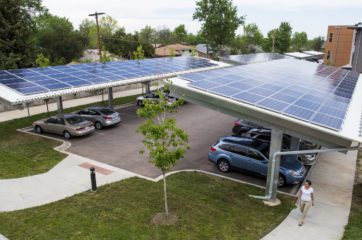After the highly enthusiastic State of the State in Rhode Island last week, Governor Gina Raimondo signed an executive order on January 17th mandating the state to move towards 100% renewable energy by 2030. This is the most ambitious ten-year energy target that currently exists in the U.S., and will hopefully spur other states to take on similarly aggressive renewable energy goals.
Rhode Island is already on track to meet its other clean energy goals, such as the 2017 target to increase renewable energy supply ten-fold by 2020, and the energy commissioner’s goal to ensure 33% of the electric sector is renewable in the coming years. The new executive order increases the ambition of these targets.
Next steps
The Governor’s order is set to make massive progress in Rhode Island’s energy sector very quickly. This will be finalized after the Office of Energy Resources releases a report it was mandated to conduct by the Governor, which will analyze the state’s economy and energy sector to outline a plan for reaching the 2030 target.
Gov. Raimondo has stressed the importance of including non-governmental stakeholders in this process to maximize civil society’s influence in establishing new programs. Historically, increased involvement of civil society allows for greater public acceptance and adherence to policy, and hopefully the Rhode Island report will therefore yield these results.
The renewable energy market will expand
Early projections have shown that renewable energy markets will need to greatly increase in order to meet the Governor’s target; solar energy currently accounts for only 1% of Rhode Island’s energy, and hydropower accounts for only 0.3%. There is massive potential to expand these industries.
Gov. Raimondo is also focused on expanding offshore wind energy, which is already a primary energy source in the state, and is predicted to power half the homes in Rhode Island within the next few years. Rhode Island has always been a leader in wind energy after launching the country’s first offshore wind project off of Block Island in 2016. The Governor plans to utilize Rhode Island’s progress and leadership in that sector to reach her 2030 renewable energy target.
The wind, solar, and hydro market expansion will also bring along with it job creation, which garnered Gov. Raimondo’s executive order great approval from many different groups, including environmental organizations, wind and solar industries, and trade unions.
In her executive order, Gov. Raimondo cites that “Rhode Island’s clean energy sector has seen a 74% increase in jobs since 2014.” She has emphasized the fact that renewable energy can help propel economic growth.
This coincides with national trends away from coal and oil towards renewables. It is expected that by 2021, renewable energy will overtake coal and natural gas as the leading energy source in the nation, creating tremendous job opportunities in renewable sectors across the country.
Including environmental justice
Ensuring that renewable energy projects are sourced locally will be essential in projected job expansion, and should be an important part of the state’s plan. “We want to be increasing renewable energy that actually adds renewable projects locally,” Leah Bamberger, the Director of Sustainability in Providence, told Climate XChange.
To her, environmental justice and energy democracy are important factors when considering the expansion of renewable markets. She says the state must “make sure that we’re not just unplugging from one source and plugging into another without addressing some of the other issues that come with our energy system. We don’t want to be so narrow in our approach to renewables that we leave people behind.”
In Providence, a recently released Climate Justice Plan takes environmental democracy into account. The plan was co-developed by both the City of Providence’s Office of Sustainability and the Racial and Environmental Justice Committee of Providence, and outlines a roadmap to bring to Providence a just and fair transition towards renewable energy. It will be crucial that the Governor’s study include these justice provisions as well, so that Rhode Islanders are able to benefit in an equitable way.
How will Rhode Island follow through with the order?
There are certainly many questions that have risen in the wake of the executive order. It is unclear, for instance, whether the natural gas industry will continue to grow or be heavily reduced. This is especially important considering that in 2018, natural gas accounted for 93% of Rhode Island’s energy generation. A large percentage of this natural gas derives from high-carbon emitters, including wood and landfill based gas, which destroy local resources. Critics worry that without setting regulations on natural gas industries, the Governor’s executive order may not be as effective as she hopes.
There are also questions about legislative backing of the order — primarily due to House Speaker Nicolas Mattiello. Although he has stated that he will support climate legislation, there have been a severe lack of climate-related bills that Mattiello has allowed to pass through the House during his tenure as speaker. He has also made the point that climate change is a national problem and he does not believe it should be addressed at the state level.
Despite pushback from Mattiello, Governor Raimondo has been steady in emphasizing the need to address climate from the state level, understanding that legislative action may not be necessary to meet the executive order targets. However, there is some concern that not putting the renewable energy goal into law means that it could easily be rescinded by future Governors.
Environmental advocacy groups are also frustrated that Governor Raimondo lacks a plan to push climate policy through the state legislature, and has focused primarily on executive action that sponsors climate studies rather than passing bills.
“There are already so many studies, but no policies or programs to show for it,” says Kai Salem, Policy Coordinator at Green Energy Consumers Alliance. “We want to see policy.” She has been “frustrated by the rhetoric that implies that [the executive order] will get Rhode Island to 100% renewable energy,” when in fact it is simply a study.
Legislative history
In both 2018 and 2019, a Global Warming Solutions Act was introduced in the Rhode Island legislature, which would’ve mandated an economy wide cap on emissions. It has yet to pass through the House.
A similar bill is expected to be introduced in the current session, and it will be interesting to monitor its progress considering the ambitious goals of the Governor early this year. This bill would make the Governor’s reduction goals legally binding.
This legislation would also build upon the 2014 Rhode Island Resilient Act, which sets economy-wide emission targets for Rhode Island to meet by 2050, but is not mandatory. A Global Warming Solutions Act structured similarly to those proposed in the past would make this enforceable as well.
“Having binding targets will be really important for the state to make sure we are making progress and are accountable to that,” mentions Bamberger.
The executive order in a broader context
There is additional concern that the executive order focuses solely on energy, which makes up only 26% of Rhode Island’s economy, and does not include other areas of the economy. Economists worry that this could harm other economic sectors that are not up included in the cap by creating a gap in prices within an economy.
Gov. Raimondo addressed this by stressing that her executive order is just one component of a reduction of emissions throughout the economy. The order includes commitment to the Transportation and Climate Initiative, a program to cap transportation emissions throughout multiple northeastern states, as well as a reference an executive order submitted by the Governor in 2019 that requires state agencies to reduce emissions in the heating sector.
These programs have yet to be enacted, but Rhode Island needs strong climate policy urgently. Because of Rhode Island’s coastal location, the state is particularly vulnerable to the effects of climate change. It is essential that Rhode Island puts into law measures to ensure that these ambitious goals supported by the Governor are met, and that the transition to a clean economy — throughout all sectors — is possible and equitable.









